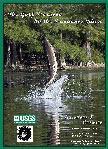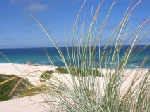
ABOUT FISC
SCIENCE WEBSITES
DATA CENTER
CENTER INFORMATION
OFFICE ADDRESSES
FISC - Headquarters
12703 Research Parkway
Orlando, FL 32826
Tel: 407-803-5500
Fax: 407-803-5501
FISC - Crown Pointe
2201 NW 40 Terrace
Gainesville, FL 32605
Tel: 352-374-8080
Fax: 352-373-5763
FISC - Gainesville Lab
7920 NW 71st Street
Gainesville, FL 32653
Tel: 352-378-8181
Fax: 352-378-4956
|
FISC - Biology
Research and monitoring to meet the needs of managing the resources of the southeastern region
FISC biological science capabilities include applying Adaptive Management research and tools to resource management decisions that involve high levels of uncertainty. This work is done in cooperation with federal and community partners to address societal needs. Biologists at FISC are also involved in gathering long term data sets to examine changes in populations and habitats over time. A well known data set is the Manatee Photo Identification Database. Manatees are just one example of key indicators species that are part of long term ecosystem studies. American alligators are another example of an indicator species that provides scientists and resource managers with insight into ecosystem health based on the population health of alligators in their natural environment.
One of Florida's, and the nation's most critical environmental threats is the increased numbers and populations of invasive species. Across the nation invasive species are impacting rivers, wetlands and lakes. The FISC NAS program maintains up to date information on invasive and exotic species across the country providing species alerts, fact sheets and maps to track and predict the spread of invasives.
USGS Florida Science Highlights
DISCOVRE 2009
 During their 12-day mission, the Life on the Edge 2009 team of researchers and educators aboard the Research Vessel Seward Johnson will explore the biological diversity, connections, and habitat associations of the deep reef communities off the Cape Canaveral area of Florida. This is the first in a series of four deep reef-related cruises in 2009 that will range from North Carolina through the Gulf of Mexico. To read daily ship logs from the team, to ask a question of a scientist on board the vessel, or to see pictures from the cruise During their 12-day mission, the Life on the Edge 2009 team of researchers and educators aboard the Research Vessel Seward Johnson will explore the biological diversity, connections, and habitat associations of the deep reef communities off the Cape Canaveral area of Florida. This is the first in a series of four deep reef-related cruises in 2009 that will range from North Carolina through the Gulf of Mexico. To read daily ship logs from the team, to ask a question of a scientist on board the vessel, or to see pictures from the cruise  Click Here Click Here
Hydrology, Water Quality, and Aquatic Communities of Selected Springs in the St. Johns River Water Management District, Florida
 Hydrologic, physicochemical, and aquatic community data were collected and compiled by the U.S. Geological Survey for selected springs within the St. Johns River Water Management District from January 2004 to October 2007. Nine springs were included in this study: Alexander, Apopka, Bugg, De Leon, Gemini, Green, Rock, Silver Glen, and Wekiwa. Urban lands increased in Alexander, Apopka, De Leon, Gemini, Green, and Wekiwa springsheds between 1973 and 2004, accompanied by a loss of forested and/or agricultural lands in most springsheds. Hydrologic, physicochemical, and aquatic community data were collected and compiled by the U.S. Geological Survey for selected springs within the St. Johns River Water Management District from January 2004 to October 2007. Nine springs were included in this study: Alexander, Apopka, Bugg, De Leon, Gemini, Green, Rock, Silver Glen, and Wekiwa. Urban lands increased in Alexander, Apopka, De Leon, Gemini, Green, and Wekiwa springsheds between 1973 and 2004, accompanied by a loss of forested and/or agricultural lands in most springsheds.  Learn More Learn More
The Gulf Sturgeon in the Suwannee River — Questions and Answers
 The Sturgeons and paddlefishes are modern descendants of an ancient group of freshwater fishes, the Chondrostei (a group of bony fishes with mostly cartilaginous skeletons). Sturgeons evolved during the Age of the Dinosaurs, and have prospered in the large rivers and lakes of North America, Europe and Asia for 200 million years. Together with alligators and crocodiles, they survived the mass extinction at the end of the Mesozoic Era, when the dinosaurs and many other groups of animals disappeared forever. The Sturgeons and paddlefishes are modern descendants of an ancient group of freshwater fishes, the Chondrostei (a group of bony fishes with mostly cartilaginous skeletons). Sturgeons evolved during the Age of the Dinosaurs, and have prospered in the large rivers and lakes of North America, Europe and Asia for 200 million years. Together with alligators and crocodiles, they survived the mass extinction at the end of the Mesozoic Era, when the dinosaurs and many other groups of animals disappeared forever.  Learn More Learn More
Florida Sand Removal Impact Assessment Database
 The MMS has identified an immediate need to compile a synopsis of available literature on existing environmental conditions in Federal waters along the Florida coastline. The USGS comprehensive literature database provides information on the existing physical, biological, and socioeconomic conditions of the Florida marine environment, including potential dredging and sand placement sites, as well as any potential effects the proposed dredging and placement activities might have on these environments. The MMS has identified an immediate need to compile a synopsis of available literature on existing environmental conditions in Federal waters along the Florida coastline. The USGS comprehensive literature database provides information on the existing physical, biological, and socioeconomic conditions of the Florida marine environment, including potential dredging and sand placement sites, as well as any potential effects the proposed dredging and placement activities might have on these environments.  Access the Database Access the Database
 Biology Highlights - 2009 Biology Highlights - 2009
Of Current Interest
Contaminant Biology Program
 Environmental contaminants (EC) are one of many stressors impacting ecosystems. Environmental contaminants originate from a variety of human activities including industry, energy production, agriculture, transportation, recreation, wastewater treatment, and urban horticulture. The magnitude of that contamination may range from the apparently innocuous such as pesticide runoff from lawns and gardens to the extreme such as hazardous waste from affected sites (Superfund sites). Environmental contaminants (EC) are one of many stressors impacting ecosystems. Environmental contaminants originate from a variety of human activities including industry, energy production, agriculture, transportation, recreation, wastewater treatment, and urban horticulture. The magnitude of that contamination may range from the apparently innocuous such as pesticide runoff from lawns and gardens to the extreme such as hazardous waste from affected sites (Superfund sites).  Learn More Learn More
Silent Streams?
 Nearly 40 percent of fish species in North American streams, rivers and lakes are now in jeopardy, according to the most detailed evaluation of the conservation status of freshwater fish in the last 20 years. Nearly 40 percent of fish species in North American streams, rivers and lakes are now in jeopardy, according to the most detailed evaluation of the conservation status of freshwater fish in the last 20 years.
The 700 fishes now listed represent a staggering 92 percent increase over the 364 listed as "imperiled" in the previous ![holiday darter [Etheostoma brevironstrum (Amicalola Creek population)] Photo by Noel Burkhead, USGS](https://webarchive.library.unt.edu/eot2008/20090825081558im_/http://fl.biology.usgs.gov/images/thumbnails/etheostoma_brevirostrum_hol.jpg) 1989 study published by the American Fisheries Society. Researchers classified each of the 700 fishes listed as either vulnerable (230), threatened (190), or endangered (280). In addition, 61 fishes are presumed extinct. 1989 study published by the American Fisheries Society. Researchers classified each of the 700 fishes listed as either vulnerable (230), threatened (190), or endangered (280). In addition, 61 fishes are presumed extinct.
 Go to the Website Go to the Website
 USGS Press Release USGS Press Release
Recent Publications
 Open-File Report 2009-1145 Walsh, S.J., Buttermore, E.N., Burgess, O.T., and Pine, W.E., III, 2009, Composition of Age-0 Fish Assemblages in the Apalachicola River, River Styx, and Battle Bend, Florida: U.S. Geological Survey Open-File Report 2009-1145, 28 p. Open-File Report 2009-1145 Walsh, S.J., Buttermore, E.N., Burgess, O.T., and Pine, W.E., III, 2009, Composition of Age-0 Fish Assemblages in the Apalachicola River, River Styx, and Battle Bend, Florida: U.S. Geological Survey Open-File Report 2009-1145, 28 p.
|
Murie, D. J., D. C. Parkyn, L. G. Nico, J. J. Herod, and W. F. Loftus. 2009. Age, differential growth and mortality rates in unexploited populations of Florida gar, an apex predator in the Florida Everglades. Fisheries Management and Ecology 16(4):315-322. |
Lanyon, J.M., H. Sneath, J.R. Ovenden, D. Broderick and R.K. Bonde. 2009. Sexing sirenians: validation of visual and molecular sex determination in both wild dugongs (Dugong dugon) and Florida manatees (Trichechus manatus latirostris). Aquatic Mammals 35(2):187-192. |
 Fact Sheet 2009-3002 Langtimm, C.A., Swain, E.D., Stith, B.M., and others, 2009, Integrated Science: Florida Manatees and Everglades Hydrology: U.S. Geological Survey Fact Sheet 2009-3002, 4 p. Fact Sheet 2009-3002 Langtimm, C.A., Swain, E.D., Stith, B.M., and others, 2009, Integrated Science: Florida Manatees and Everglades Hydrology: U.S. Geological Survey Fact Sheet 2009-3002, 4 p.
|
 Search our publications Search our publications
Florida Weather
|
